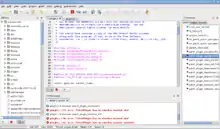Anjuta
Anjuta was an integrated development environment written for the GNOME project.[7] It had support for C, C++, Java, JavaScript, Python and Vala programming language.[8] In May 2022, the project was archived due to a lack of maintainers.[9] Since October 2022 the project's former homepage no longer exists and the domain is owned by an SBOBET, an Indonesian gambling website. It has been superseded by GNOME Builder.
 | |
Screenshot  Anjuta in action | |
| Original author(s) | Naba Kumar |
|---|---|
| Developer(s) | Johannes Schmid, Sébastien Granjoux, Massimo Cora, James Liggett and others |
| Initial release | December 27, 1999[1] |
| Final release | 3.34.0 [2] (September 8, 2019) [±] |
| Preview release | (none)
|
| Repository | gitlab |
| Written in | C (GTK) |
| Operating system | Unix-like |
| Platform | GNOME |
| Successor | GNOME Builder |
| Available in | 41 languages(with translation ≥ 50%)[3] |
| Type | Integrated development environment |
| License | GPL-2.0-or-later[4][5] |
| Website | web |
| Final release | 3.26.0
/ September 10, 2017[6] |
|---|---|
| Repository | gitlab |
Anjuta DevStudio
The goal of Anjuta DevStudio was to provide a customizable and extensible IDE framework and at the same time provide implementations of common development tools. Libanjuta was the framework that realizes the Anjuta IDE plugin framework and Anjuta DevStudio realizes many of the common development plugins.
It integrated programming tools such as the Glade Interface Designer and the Devhelp API help browser.
Features
Anjuta features:[10]
- Interactive debugger built over GDB and integrated compiler
- Source code editor with source browsing,
- code completion and syntax highlighting,
- Project management
- Application wizard
- CVS and Subversion version control system integration[11]
Reception
The German magazine LinuxUser recognized Anjuta 1.0.0 (released in 2002) as a good step to increase the number of native GNOME/GTK applications, stating that the application has a very intuitive GUI and new useful features.[12]
In April 2017, Anjuta was removed from the OpenBSD ports tree, with stagnation of development and existence of alternatives cited as reasons.[13]
References
- "Anjuta DevStudio: Integrated Development Environment". projects.gnome.org. 1999-12-27. Retrieved 2010-05-12.
- "Anjuta project news file". Retrieved 2021-08-28.
- Naba Kumar. "Module Statistics: anjuta". l10n.gnome.org. Retrieved 2019-06-10.
- ":: Welcome to Anjuta ::". Archived from the original on 2001-10-21. Retrieved 2021-06-22.
- Schürmann, Tim (2002). "schweizer messer - Entwicklungsumgebungen im Vergleich". LinuxUser (in German) (2). Retrieved 23 March 2012.
- Granjoux, Sébastien (2017-09-10). "Anjuta extra 3.26.0 released".
- Stiebert, Julius (12 March 2008). "Gnome 2.22 mit Desktop-Effekten" (in German). Golem.de. Retrieved 23 February 2012.
- "Archived Anjuta project homepage". 2022-11-07. Archived from the original on 2022-10-07. Retrieved 2023-05-15.
{{cite web}}: CS1 maint: bot: original URL status unknown (link) - "Archival Notice".
- Ganslandt, Björn (2001). "GNOME Fifth-Toe 1.4". LinuxUser (in German) (5). Retrieved 2019-06-10.
- "Project readme". 2019-06-10.
- "News und Programme rund um Gnome". LinuxUser (in German) (1). 2003. Retrieved 23 March 2012.
- Adriaanse, Jasper Lievisse (17 April 2017). "remove anjuta". Retrieved 18 April 2017.
Further reading
- Schulz, Hajo (2002). "Selbst geschneidert — Software-Kollektion für Entwickler". c't (in German) (13): 150.